
COME AND SHOP LOCAL


COME AND SHOP LOCAL
URBAN HARVEST FARMERS MARKET

Every Saturday; 8:00 am to Noon
2752 Buffalo Speedway
URBAN HARVEST MOBILE MARKET Visit www.urbanharvest.org for locations
Urban Harvest cultivates thriving communities through gardening and access to healthy, local food. We are improving the lives, soil, and plates of all Houstonians through: the Farmers Market, Organic Gardening & Nutrition Education, Healthy Food Access, and Community Gardens.

CLASSES LEARN MORE
Insectary Gardens: Nature’s Pest Control, Wildlife Habitat Gardens at Home, Starting Fall Tomatoes, Healing Culinary Herbs, Preparing for Fall Organic Gardening and much more!
EVENTS

Secret Supper September 21
Cultivators Cocktails October 19
Sunday Supper November 5
Visit urbanharvest.org

Food keeps us connected — connected to family, friends, our hometowns and homelands. This is especially true in Houston, which has long been a city that immigrants, refugees, migrants and their families have called home. I didn’t set out to explore these connections in this issue, it just happened. But maybe it was inevitable because so many stories about food in Houston turn out to be about maintaining, sharing and growing our roots.
In this issue, we highlight Mansour and Karim Arem, Tunisia-Texan brothers who started a food company grounded in their family’s Tunisian cooking. We profile chef Beatriz Martines, who started her culinary career as an elementary school lunch lady and has now opened a restaurant that explores her Mexican heritage. And we visit community gardens in Alief where immigrants and their families are growing fruits and vegetables that connect them to their home countries and their new neighbors. We also travel to Hill Country lavender farms inspired by France and discuss restaurants and products worth trying, from a Caribbean restaurant helmed by a Trinidadian chef to cheese made by an Italian who missed the cheeses of his homeland.
Food, especially locally grown fruits and vegetables, also keeps us connected to the land, weather and seasons. We know it’s summer, which in Houston starts long before the solstice, when we find peaches, eggplant, okra, cucumbers, sweet potato greens and melons at the farmers market. We know it’s time to dig out that favorite eggplant recipe or try something new such as the recipe for a refreshing watermelon, cucumber and mint agua fresca you’ll find in this issue.
We hope the stories we share at Edible Houston keep you connected to our community. If so, drop us a line and consider subscribing.
Happy Summer and Stay Cool!
PUBLISHER
Monique Threadgill monique@atxpublications.com
ASSOCIATE PUBLISHER/ CREATIVE DIRECTOR



Ralph Yznaga ralph@atxpublications.com
EDITOR
David Leftwich david@ediblehouston.com

COPY EDITORS
Claire Cella
Stacey Ingram Kaleh
CONTRIBUTING WRITERS
Ashley Brown Stacey Ingram Kaleh
Paula Niño Kehr
MM Pack
Isabel Protomartir
Pauline Stevens
Jamie Threadgill
CONTRIBUTING PHOTOGRAPHERS
Baylie Beebe
Marlon Rincón
Sonya Sellers
Pauline Stevens
ADVERTISING SALES
Advertising Sales info@ediblehouston.com

DISTRIBUTION
Nathan Simmons tmem23@gmail.com
CONTACT US 5524 Bee Caves Rd., Ste. J-4 Austin, TX 78746

512-441-3971 info@ediblehouston.com
Edible
Houston is published quarterly by ATX Publications LLC. All rights reserved. No part of this publication may be used without written permission of the publisher. ©2023. Every effort is made to avoid errors, misspellings and omissions. If, however, an error comes to your attention, please accept our apologies and notify us. Edible Houston is a member of Edible Communities.


When Andrea Cudin, who is from northeastern Italy, moved to Victoria, Texas, in 2012, he couldn’t find the cheeses he loved, so he made his own. Knowing that good cheese starts with good milk, he partnered with Four E Dairy outside Moulton in Lavaca County. His creamery, Lira Rossa Artisan Cheese, is located on the third-generation dairy farm, giving him easy access to fresh, raw milk from the Jersey and Jersey-cross cows tended by the Chaloupka family.
With that milk, Cudin and his team make a variety of Italian -style cheeses including a creamy, ricotta fresca; a milky mozzarella; moultonzola, a funky, Italian-style blue; and robiola, a rich, soft-ripened cheese from the hilly Langhe region of Italy. They also produce a unique Texas-Italian take on the soft, creamy surface-ripened French favorite, camembert. As the inoculated Texas milk ripens from the outside in, it produces a luscious, silky cheese that opens with hints of sweet butter and finishes with suggestions of dark chocolate. Cleverly called C’mon Berto!, this cheese is perfect for a cocktail party spread served with a drizzle of local honey or dollop of Garden Dreams strawberry jam, or enjoyed as a snack on crackers, maybe with a sprinkle of Aleppo pepper and some flaky sea salt. Lira Rossa cheeses can be found at Urban Harvest’s Saturday Farmers Market, local shops such as Henderson & Kane and the Asch Building Market and select Central Market locations.
If you’re in Austin, you can purchase Lira Rossa on Sundays at Texas Farmers Market at Mueller. lirarossa.com

A good meal deserves a good ending and sleepy afternoons need a tasty pick-me-up. The imaginative, handmade chocolate delights created by sisters Susy and Cristy Vazquez are both. In 2019, the sisters founded Migaloo Chocolatier to honor the late husband of the eldest sister. He dreamed of starting an artisan chocolate company as they toured many artisan chocolate shops together. That dream goes beyond just making treats using fine Belgian and Mexican chocolates.
“We are proud of being part of the Cocoa Horizons Foundation, where all of us can be part of the story of improving the livelihoods of cocoa farmers and their communities through the promotion of sustainable, entrepreneurial farming, improved productivity and community development, which protect nature and children,” says Susy.
Based in Cypress, the sisters offer a wide array of artisan chocolates such as boxes of truffles, bars that range from flavored white chocolate to dark chocolate with various percentages of cacao, vegan chocolate and chocolate barks in various flavors, including my current favorite rosemary, orange and almond dark chocolate. The bark’s robust, silky dark chocolate expresses hints of coffee that pairs well with the herbaceous spark of rosemary, crunch of almond and tart charge of orange. The sisters’ products are available at area farmers markets such as Smith Street, Tomball, Rice Village, Heights Mercantile, Rice Village, MKT Sunset and McKinney Street; seasonal pop-ups; retailers like Henderson & Kane, Central City Co-op, Local Foods and Houston Dairymaids; and via their website.
migaloochocolatier.com

In 1983, Zohrab and Arpi Tcholakian, Lebanese immigrants of Armenian descent, opened a small deli on Westheimer in west Houston that sold shawarma and a handful of Mediterranean and Middle Eastern groceries. Over the years the grocery selection grew and, in 2006, they opened Phoenicia Specialty Foods, a 55,000-square-foot store across the street from the original deli. It quickly became one of the premier gourmet grocery stores in Houston with a selection of over 15,000 products from over 50 countries. In 2011, they opened a second store downtown next to Discovery Green.
Highlights include a large selection of imported olive oils, housemade pita breads that hover through the store on a hanging conveyor belt and Phoenicia-branded spices. One of my favorites is the store’s Aleppo pepper, which is called “pul biber” in Turkey. Named after Syria’s second largest city, this spice is made from semi-dried and crushed Halaby pepper, a variety of the ubiquitous Capsicum Annuum (the Americas native that is the source of everything from sweet bell peppers to cayenne). Aleppo pepper expresses a complex synthesis of earthy sweetness, fruity tang and a slow-building medium heat that is much richer than the one note of most crushed red pepper flakes. It can be used not only in recipes from that region but also as a substitute for crushed red pepper.
Initially, middle school teachers Kirk and Elaine Lupovitch O'Neal planned to sell the produce they grew in their home garden as vendors at Urban Harvest’s now-closed satellite farmers market at Highland Village. Shortly after joining the market, they had a bumper crop of Meyer lemons, more than they could sell. To maximize their harvest, the couple turned to a time-tested method of preserving citrus — making marmalade. This decision led their new business in a different direction. “We were drawn to the craft of preserving food in the form of jams, jellies, marmalades, conserves and pickled vegetables,” says Kirk.
To better understand the art and science of transforming and conserving fruits and vegetables, the couple received certification in food preservation from Louisiana State University and then got a manufacturers license. They now make a variety of preserves including strawberry, strawberry balsamic, peach, blackberry, mayhaw (a small, red native fruit that likes moist soil) and a variety of pepper jellies. My personal favorite is strawberry rhubarb pie jam, which combines the sweetness of Texas strawberries with the tartness of rhubarb to create a well-balanced spread that’s perfect on morning toast or a mid-day PB&J. You can currently find Garden Dreams’ products at Urban Harvest’s Saturday Farmers Market and Houston Dairymaids cheese shop. On Instagram @gardendreamstexas
thanksdanks.com
Houstonians love fried chicken, and we have a menagerie of great options from Southern-style to spicy, double-fried Korean. So, it’s not easy for a newcomer to capture the attention of the Bayou City. But chef and pitmaster Greg Gatlin, who was a 2023 James Beard Award semifinalist for his cooking at Gatlin’s BBQ, has done that with lettercrisp-yet-tender fried chicken at his newest restaurant, Gatlin’s Fins & Feathers. The eatery opened last year in historic Independence Heights, the first incorporated African American city in Texas (before it was annexed by Houston in 1929).
But there is more to this home-style restaurant. The menu — developed in partnership with chef de cuisine Darius King and former executive chef Michelle Wallace, who recently launched her own venture B'tween Sandwich Co. — explores the joys of Gulf Coast comfort food from chargrilled oysters and platonically ideal buttermilk biscuits to fried catfish and a bowl of gumbo brimful with chicken, shrimp, crab, smoked sausage and okra. Don’t skip the sides such as red beans and rice, basil coleslaw and collard greens slowly braised with smoked turkey.
The earthy, slightly bitter greens combined with a hint of spicy heat and smokiness are some of the best I’ve had. You, like me, might find yourself drinking the rich pot liquor right from the bowl and wondering when you can return for more.
Visit at 302 W. Crosstimbers St. | gatlinsfinsandfeathers.com
FARM-TO-TABLE, CARIBBEAN-INSPIRED
Houston’s best food is often found in what some may consider unlikely places such as gas-station strip centers. That’s the case with Kuji Kitchen, which shares a building with a

farmers Ivy Walls of Ivy Leaf Farms and Jeremy Peaches of Fresh Life Organic — the duo who also co-founded the recently-opened Fresh Houwse Grocery — to launch this Caribbean-inspired café that serves breakfast, lunch and dinner in Southeast Houston. Breakfast options include: a breakfast sando, which comes in various options; two customizable breakfast platters; island shrimp and grits with sautéed Gulf shrimp, bacon, avocado and roasted bell pepper broth over smoked cheese grits; a full coffee program; and more. The lunch and dinner menu, which changes with the seasons, not only explores Caribbean cuisines but also its intersection with African American foodways. Try the delectable masala braised beef that pays homage to Indo-Caribbean cuisines, which developed when Indians arrived on islands colonized by the British, paired with sides such as sweet potato croquettes and Gullahstyle greens, honoring the unique African American culture of the coastal Southeast. Or dig into a snappy Jamaican-inspired jerk chicken with plantains and a side of coconut rice and peas and garden vegetables. There are also several burger and sandwich options and a rum pound cake for dessert. And don’t miss the house-made iced teas such as the tart sorrel (hibiscus) tea energized with ginger. Visit at 8601 Martin Luther King Blvd. | kujikitchenhtx.com

In Texas, the kolache has adapted — both linguistically and culinarily. The word “kolache” has, for better or worse, become what Texans call all types of Czech-inspired, fluffy pastries, whether sweet or savory, even though the popular sausage-filled version is technically a klobásník. The fillings have acclimated with the language, incorporating flavors and ingredients found in Texas from boudin to barbecue to butter chicken. Randy and Lucy Hines have been part of that evolution since they purchased the Kolache Shoppe on Richmond from longtime owner Erwin Ahrens in 2014. The couple have preserved Ahrens’ traditional approach to yeast dough while expanding to three, and
soon four, locations in the Houston area with a franchise model that involves working with fellow mom-and-pop owners who are committed to maintaining the neighborhoodfocused character of each location.
At these locations, the couple have introduced new elements to the traditional kolache shop. They developed an extensive craft coffee program that includes monthly specials such as a Biscoff latte made with milk simmered with Biscoff cookies and yearround offerings like Vietnamese cold brew. In addition, they have partnered with local vendors to create unique kolaches such as a smoky brisket, egg and cheddar kolache made with Pinkerton’s Barbecue brisket and a whipsmart venison and cheese version stuffed with sausage made by Prasek’s Family Smokehouse in Central Texas. There are also monthly specials such as recent collaborations with burger-chan to create a cheeseburger kolache, Tex-Mex-favorite Molina’s to make a Frito pie kolache, and Houston creole-classic Brennan’s
to offer one filled with crawfish and andouille. Of course, there are traditional sweet flavors such as blueberry and peach. All of this combines to keep this traditional Czech staple thriving in the 21st century.
Visit at Houston Greenway: 3945 Richmond Ave., Houston Heights: 1031 Heights Blvd., Kingwood: 4521 Kingwood Dr., Pearland: 11940 Broadway St. (coming soon) | kolacheshoppe.com
In a low-slung, nondescript building on the edge of Norhill Heights, familyowned Street Food Thai Market, which is half-grocery store, half-restaurant serves some of Houston's best Northern Thai and Laotian food. Though the eatery has only a handful of colorful tables, it offers an extensive range of dishes. These include classics such as pad thai and stir-fried basil. However, be sure to try the Northern Thai specialties (under “Esarn Classic” on the menu) such as yum nam khao tod. This robust dish is a symphony of tastes and textures. The salty, slightly tangy esarn sausage plays well with spritzes of bright, acidic lime; the verve of the spicy chile dressing; and the crunch of peanuts and fried rice balls, which have been broken into bitesize nuggets.
Also worth trying is the market’s version of khao soi gai, another Northern Thai specialty. This creamy, coconutbased curry soup is a nuanced delight that interlaces noodles and tender chicken with
fragrant toasted spices, a judicious level of chile heat and poignant mustard greens. The lovely yellow concoction is topped with fried shallots and crispy noodles, adding crunch to every spoonful. Once you finish the last bite, you’ll likely be planning your next visit — with several friends, so you can reorder your favorites, but all also try new dishes such as deep-fried whole white pompano with Thai triple-flavored sauce.
Visit at 1010 W. Cavalcade St. | streetfoodthaimarket.com
Previous Page:
Upper Left: Fried chicken and collard greens at Gatlin's Fins & Feathers

Lower Center: Jerk kitchen at Kuji Kitchen
Right Page:
Lower Left: Kolaches at Kolache Shoppe
Upper Right: Yum nam khao tod at Street Food Thai Market

Erica Raggett launched A 2nd Cup as a coffee shop pop-up to help raise awareness about human trafficking. As her mission grew, so did the coffee shop. In 2015, A 2nd Cup moved into a spacious brick-and-mortar home on 11th Street in the Heights. However, in fall 2022, the landlord sold the building, and Raggett and her team had to find a new location. Happily, customers didn’t have to wait long. In early December 2022, A 2nd Cup reopened in a contemporary-yet-homey space in Lindale Park.
From there, the group offers a full array of coffee drinks from classics such as flat whites to house specials such as the Secret Squirrel, a double shot of espresso with housemade hazelnut and amaretto syrups and milk. The kitchen serves, from 7:30 a.m. to 5 p.m., a selection of pastries and made-to-order dishes such as fresh, hearty breakfast tacos, Southern breakfast biscuits with a choice of bacon or sausage, a full breakfast plate and more. The food and drinks are likely to be prepared and served by participants in 2nd Cup’s Brazen Table program, which provides job-and
life-skills training for survivors of human trafficking. In addition, the group hosts

Chao with chef Tony Nguyen. In 2022, Ha and Nguyen were James Beard Finalists for Best Chef: Texas and, in 2023, semifinalists for Outstanding Chef for their work at Xin Chao. Ha closed the original food stall and, in February 2023, opened a brick-and-mortar reboot of The Blind Goat in Spring Branch. The modern, airy restaurant, in a revamped strip center on Long Point, is bathed in soothing blues and greens and uses vertical arrays of ropes to divide the dining room. The new location also features a full bar that offers wine and cocktails, a patio, more seating and a bigger kitchen.
life-skills training for survivors of human trafficking. In addition, the coffee shop hosts regular educational events about human trafficking and partners with other organizations fighting this crisis, often providing financial and in-kind support.
Visit at 4928 Fulton St. | a2ndcup.com
Chef Christine Ha, who won Season 3 of Master Chef, has been busy. In 2020, during the height of the pandemic, the first iteration of her Vietnamese eatery The Blind Goat, a stall in Bravery Chef Hall, was a James Beard semifinalist for Best New Restaurant. That same year, she opened modern Vietnamese-Texan Xin

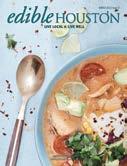
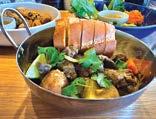
The new space gives Ha the opportunity to create new dishes such as zesty crawfish and garlic noodles, her Bayou City take on San Francisco’s classic garlic noodles, while perfecting signature dishes like G.O.A.T. Curry. This stew combines perfectly tender goat with a jus that is both light and rich with the gingery citrus of lemongrass and subtle zings of spicy heat. Then there are the eggrolls inspired by her mom’s version, perfectly crisp wrappers stuffed with a flavorful mix of pork, shrimp and wood ear mushrooms. The focused menu offers many reasons to come back — from Texas BBQ brisket fried rice, which uses smoked brisket from their plazaneighbor Feges BBQ, to whole roasted turmeric fish. No matter what you get, don’t miss Ha’s nowfamous Rubbish Apple Pie that weaves in fragrant zips of star anise, ginger and lemongrass and is drizzled with rich, sweet and savory fish sauce caramel.
Visit 8145 Long Point Rd. | theblindgoat.com



David Leftwich is editor of Edible Houston and loves to cook locally grown vegetables and hang out with his daughter, wife and a few too many stacks of books.

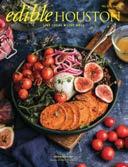


Upper Left: Breakfast tacos and flat white at A 2nd Cup Lower Center: G.O.A.T. Curry at The Blind Goat

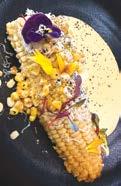 WORDS BY PAULA NIÑO KEHR | PHOTOS BY MARLON RINCÓN
WORDS BY PAULA NIÑO KEHR | PHOTOS BY MARLON RINCÓN
The al pastor pork at Xalisko — chef Beatriz Martines' new restaurant in The Woodlands — arrives on a miniature vertical spit, topped with a thick slice of pineapple. It's a table-top version of the traditional trompo, the rotating device used in many parts of Mexico to cook meats with a vertical grill. Served with fresh, housemade corn tortillas, Beatriz's version pays homage to the beginning of her culinary career.
Growing up in Guadalajara, in the state of Jalisco, Mexico, food was at the heart of Beatriz's life. During her childhood, her grandmother owned a fonda — a small mom-and-pop restaurant — where her aunts also worked. From a very young age, she remembers helping them in the restaurant's kitchen, as well as in preparing family meals. “I feel like cooking is in my blood,” Beatriz says. But she never contemplated cooking as a career until later in life. Her dream was to become a teacher.
In 2000, when she was 18, Beatriz married and moved to the U.S. Her first job, in 2005, was working in the cafeterias of Willbern Elementary and Moore Elementary in the Cypress-Fairbanks Independent School District. During that time, she prepared trompo at home because her husband, Juan Martines, loved the dish. Eventually, friends began asking her to make it for special occasions, eventually referring other clients. A side catering business was born.
“Our trompito dish is a symbol of how we started here,” Beatriz says. “Although I have been involved in gastronomy since I was a child, it was only when I started doing it here that I reached a more professional level. It's a symbol, so we don't forget how we started.”
The weekend taquizas — Mexican-style taco buffets where guests make their own tacos with a variety of fillings and salsas — were just the beginning for Beatriz. One day, Juan asked her where she saw herself in five years. She says she was taken aback by the question, but Juan pointed out her passion for cooking and urged her to enroll in culinary school. He told her that just because she had married young and had kids didn't mean she had to give up her dreams. Although Beatriz agreed, she put off inquiring about culinary school until Juan surprised her with an appointment at the Art Institute of Houston.
“When I saw it, I fell in love. I had always cooked, but never professionally. That day, it was like love at first sight. I was thrilled,” says Beatriz.
The cost of the degree discouraged her, but her husband assured her they would find a way to pay for it. She started in 2011, while still working at the school cafeteria and raising her then-two children (the couple now have three).
What followed was a series of opportunities that, combined with her hard work, determination and the support of her family, put her on a path to become an accomplished chef and an example to other immigrants and women in the hospitality industry.
As a student at the Art Institute, Beatriz met Mexican celebrity chef Aquiles Nuñez, who offered her an internship and eventually hired her to work at his former Houston restaurant, La Fisheria. Beatriz finished her culinary degree in 2013, but her husband pushed her to continue studying pastry and baking the following year.

“You have to be ready to learn from everyone, from the dishwasher on, not going in thinking that you know more than anyone else”Left Page Elote Right Page: Chef Beatriz Martines
“Thanks to that, I went to Spain,” says Beatriz. The year she returned to study baking and pastry, the famous Roca brothers behind the twicenamed No. 1 restaurant in the world, El Celler de Can Roca in Girona, Spain, were visiting Houston as part of a six-city tour. Sommelier Josep Roca, chef Joan Roca and pastry chef Jordi Roca held various dinners in Houston and offered students the opportunity to apply to work at those events. Two students would then be selected to apprentice under them at their restaurant in Spain.
Beatriz forgot to send her résumé. “The deadline had passed, and I thought I had lost the opportunity, but my husband told me, 'Do it, do it right now.' He has always been my backbone that encourages me to be better, so I sent it,” she says.
When Beatriz found out she was one of the two students who won the apprenticeship, she was in shock. “She didn't want to go,” says Juan.
At the time, Beatriz had two children under the age of 6 and the thought of leaving them for six months seemed impossible. But again her husband and extended family came through, caring for the kids while she was away. During that time, Juan says he gained a new appreciation for single moms and dads. Beatriz credits the experience in Spain with opening doors and changing her professional vision. “Until you are in a place where they push you to the highest level, you don't realize what you are capable of,” she says.
Beatriz’s days in Girona were long and grueling. She felt the pressure the minute she set foot in the kitchen. On days when she thought she couldn’t handle the stress, she motivated herself by thinking of her children in Houston. "That's when I gathered the courage and said, I left them, it has to be worth it,” she says.
As a woman in the culinary world, Beatriz says she has had to work twice as hard to earn her place and respect, but she has managed.
“When you enter the kitchen, you have to enter with a confidence that you know what you're doing, even if you don't, and [with] humility. You have to be ready to learn from everyone, from the dishwasher on, not going in thinking that you know more than anyone else,” she says.
While in Spain, Beatriz met Houston chef Hugo Ortega and his brother Ruben, who is the pastry chef for Hugo’s restaurants. The pair were on a two-week visit to El Celler de Can Roca following the Roca brothers' world tour. In Houston, Juan had taken Beatriz to Ortega's restaurant, Hugo's, several times because of her love for Mexican cuisine, but she had never met the chef. Still, Beatriz often told her husband that one day she would work for Hugo. “It's funny how life works,” she says.
Hugo recalls connecting with Beatriz over the food of their native Mexico in Spain. “Her determination and willingness to say ‘yes’ to opportunities reminded me of myself as I worked to achieve my American Dream,” says Hugo.
When Beatriz returned to Houston, Hugo hired her to work for H-Town Restaurant Group (Caracol, Hugo’s, Xochi, Urbe and Backstreet Café), which he owns and operates with his wife Tracy Vaught. She started as culinary director, and later became corporate chef. Beatriz traveled with Hugo and created menus alongside him. She also trained and supervised staff at the various restaurants. She worked for Ortega for eight years but never abandoned the idea of having her own place.
“One of the reasons I went to culinary school was so that we could prepare everything perfectly for our customers. We were torn between starting a more formal catering business or a small casual restaurant. Life took me on a different path, but here we are now. We never gave up on the idea,” says Beatriz.
At Xalisko, which opened in February 2023, Beatriz pays homage to her roots, her family and her culinary journey in everything from the restaurant's decor to her creative spins on traditional recipes.
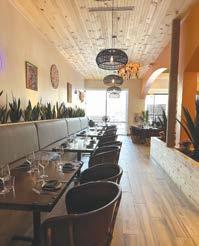

The restaurant's logo is a corn cob and the dried corn in its husk that hangs in the restaurant’s private dining room are both a nod to her late father, who grew corn in Mexico. Handcrafts and folk art from Jalisco can be found throughout the dining room. On the walls, beaded art by the Wixárika, Indigenous people from the Sierra Madre Occidental Mountain range, brings color to the room, as does the colorful woven canopy along the hallway leading to the private dining room. This crocheted piece of art is part of the 86,000-square-foot woven sky found in Ezatlán, Jalisco, which holds the 2019 Guinness World Record for the largest fabric pavilion in the world. The restaurant's rustic wooden furniture was also made in various parts of Jalisco.
Beatriz's menu is inspired by Mexico's Pacific Coast, which encompasses the states of Jalisco, Michoacán, Nayarit and Colima. It also includes several dishes that have special significance for her. Besides the aforementioned trompito, her tamal de elote and birria tatemada are both prepared using her grandmother's recipes.
The tamal de elote is presented with a modern twist. Corn is served atop corn puree, cotija cheese and corn husk ash. The birria — beef or lamb marinated with dried peppers adobo sauce, slow cooked wrapped in agave leaves — is very traditional in Jalisco, particularly for special occasions like weddings and baptisms. At Xalisko, Beatriz serves beef birria during lunch and lamb birria for dinner. Her grandmother was her town's birria maker, so she feels proud telling people that the dish at Xalisko is prepared using her recipe.
While being a restaurant owner brings different challenges than working in someone else's kitchen, Beatriz loves it. Her husband often has to remind her that it's time to go home when they find themselves at the restaurant after midnight. “I am very dedicated to what I like,” says Beatriz.
Her dedication has paid off. In March, one month after opening, Xalisko was named one of Houston’s top 25 dining destinations by the Houston Chronicle.

Beatriz sees the opening of Xalisko as the fulfillment of her dream and she says she wants to be an example for others, especially women and those who come to the United States not knowing English, that you can move forward and fulfill your dreams with patience and hard work.
“You have to work hard because nothing comes for free, you have to put in a lot of effort, but we are in a country where we are given more opportunities than in our own countries,” she says.
Xalisko, 1335 Lake Woodlands Dr, The Woodlands, xalisko.com
Th ose, like me, who are from Alief are proud to be from Alief. Pop stars, James Beard Award nominees, athletes and even a top comedian who set his popular Netflix series there boldly announce being from this quaint little community on the southwest side of Houston. As someone who grew up there, I get it. Alief hums with an energy that is so special yet so natural. It’s not trying to be anything other than what it is: home. But who calls it home? On Wikipedia, it’s touted as a “working class suburb,”but it’s more than that. Alief boasts one of the most diverse populations in a city that ranks as one of the most diverse in the nation. To paint a picture, I, a Filipino immigrant, lived on a street with Vietnamese, Nigerian, Salvadorian, Pakistani and Mexican neighbors — and that’s just one block. It was normal to shop at Viet Hoa, a Vietnamese grocery store, one day and La Michoacana, a Mexican meat market, the next. I grew up swapping lumpia for tamales during the holidays and jollof for my mom’s pancit on the weekends. That inimitable zeitgeist and understanding that I was lucky to grow up with was a beautiful thing; and something that is particularly alive in a special plot of land nestled off the corner of Dairy View and Beechnut. That land plays host to three organizations whose missions are to make sure the individuals that call Alief home are nourished, encouraged and fed.

Founded in 2011, Alief Community Garden is a volunteer-led project that is helmed by Barbara Quattro. Still a leader in the community at almost age 80, Quattro is a West Virginia native who later called Alief home. She is a lifelong volunteer committed to leaving the world better than she found it. Her mission grows as the garden grows. Alief Community Garden began with 15 5-foot-by-25-foot raised beds and today has over 90.
Each garden plot belongs to and is independently maintained by people who live in Alief. Many are immigrants from every corner of the world. In one plot, Vietnamese gardeners grow basil, lemongrass and mint. In another, Burmese families are growing elongated opo gourds for their trademark mohinga, a fish stew made with the mildly flavored squash and fermented vermicelli noodles.
“It really is something that you just see people from different backgrounds — from Africa, from Vietnam, from Latin America, native to the States — just sharing their vegetables and what they cook with them. It's just remarkable,” says Natali Hurtado, executive director of the International Management District.
IMD is what powers the Alief Community Garden, providing volunteers with the resources to help grow the program both literally and figuratively. This support has allowed the garden to also give a home to Alief Art House and FAM Houston’s Shamba Ya Amani.
IMD is a political subdivision created by the state legislature. Its goal is to “provide economic development to an area that was either blighted or going on a downward track,” says Hurtado, an Alief native herself. The organization collects 10 cents for every $100 valuation on commercial properties and reinvests that money in the community. “We don't want people to worry about their plants dying. If FAM Houston, Alief Art House, or the gardeners that have their raised beds need anything, we provide all of the bigger things like electricity and water. We're here to support them with that.”
IMD partnered with Urban Harvest, a Houston organization that provides community garden support, educational programming and manages popular farmers markets, to help them properly set up their first raised bed system. They also collaborated with the University of Houston’s College of Architecture and Design to build a pavilion for students of neighboring schools to enjoy. In recent years, they have also leaned on Hope Clinic, a facility offering patients healthcare no matter language or financial barriers. Together, they built permanent Chinese checkers stations to encourage intergenerational activities among neighbors. Two partnerships, Alief Art House and Shamba Ya Amani, have even taken up permanent residency on the sprawling 6-and-a-half-acre property.
ALIEF ART HOUSE“To me, Alief is just this amazing part of Houston that is bringing together art and the food scene,” says Hurtado. In 2019, IMD partnered with Matt Manalo to develop Alief Art House. “I feel like Matt was what we needed for that art component,” she says.
“I feel like I didn’t experience a big culture shock. Everyone basically looked like me and I didn't feel othered,” Manalo says about settling in Alief with his family after immigrating from the Philippines. His love for his new home is what brought him back years later to launch Alief Art House. His goal is to create a hub for creativity, especially for immigrants with backgrounds like his own.
On the surface, it’s a colorfully graffitied shipping container resting on the grounds of the Alief Community Garden, but the space serves as much more. The container itself has acted as a studio, a gallery and a home to collaborative art projects for the neighborhood. It recently received enough support to double its footprint. With the additional space, Manalo’s organization has planted a vegetable garden that grows vegetables and fruit for both art and sustenance. It was recently the setting for an intimate vegan Filipino food tasting.
Manalo wants the site to be a beacon of hope for young students from immigrant and minority families who want to pursue art but don’t have the support to do so. “I was an immigrant with unique stories to tell, I felt like there needed to be a space where others could do the same through art,” Manalo explains.
Like Manalo, I came to America from the Philippines at a young age. I often felt “too Filipino” and at the same time “not Filipino enough.” It wasn’t until connecting with other immigrants like Manalo later in life, that I understood this to be a common experience among us. A young artist expressing their diasporic stories and struggles in a place such as Alief Art House can be an opportunity to connect with others like themselves, while also developing a wider audience that may lead to a deeper understanding of each other.
Manalo also expresses that, “One of the main goals of the space is to show these communities that to be an artist can be sustainable. If we're showcasing a student and they get paid to showcase their work, there's something so liberating about that.”
Sustainability is a theme running throughout Alief Art House. The Alief Art Garden is working with The WOW Project, which is fighting poverty in underserved areas with community fridges that provide fresh food to people for free. Together, they started a garden where they grow food to eat and create art with. “As an artist, it’s our responsibility to make spaces beautiful, but it's also important that we think about the spaces that we interact with so we strive to make our practice more sustainable because a lot of the materials that [artists] use can be harmful for the planet,” says Manalo. The goal is to utilize what’s grown from the garden for materials or as inks and dyes. “If we can use black beans as ink, that’s even better.”
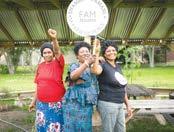
The third group to call this stretch of Alief home joined at the dawn of the pandemic and has sowed seeds of inspiration for both their farmers and the community. FAM Houston, which supports refugees and immigrants, was searching for a place for their refugee women’s empowerment group to grow fresh produce. So, they approached Alief
about extra land in the community garden. Hurtado and her team welcomed them with open arms. “I told them we have a lot of land, y'all are welcome, and now it's beyond what I thought would have happened,” she says.

The original idea was to find a small plot for their community of resettled refugees, primarily Congolese women, to grow produce and make a little income as their children attended nearby schools. “Then we found this land and it kind of just opened up the vision for what could be, so we named the land Shamba Ya Amani, which means ‘farm of peace’ in Swahili,” shares volunteer turned farm manager, Kim Meyer. Each woman tends her own dedicated raised beds with the help of volunteers and is able to make an income by selling veggies to friends and at local markets. The women are also able to nourish their own families with what they grow.
The program continues to add ways to help their farmers gain new skills. Meyer has added a fast-growing apiary program. FAM Houston partnered with Bee Mindful from Austin to set up hives on the property and has even installed hives at the Houston Botanic Garden, who now fund the program and support the apprentices.
Through their efforts at the garden, Meyer explains that they’re able to “teach [the refugees] long lasting skills that can help equip them with knowledge that can continue benefiting them.”
Not only have these refugees found a community, they’ve found a new home in Alief. “We feel like we really fit into the dynamic and area. It's kind of a magnet for people who will wander onto the farm from the surrounding neighborhood,” Meyer fondly shares. “I can't tell you how many conversations I've had where people tell me about their grandfather's farm in India and the bitter melon that they're growing in their backyard that their father used to grow. This Nigerian woman the other day was excited about the fact that we'll be growing okra that reminded her of a specific okra from her country.”
It’s this exchange of culture and understanding of a home away from home that ties these three gardens and all of Alief’s inhabitants, both new and old, together. My friends and I who grew up in Alief embracing one another’s cultures and inviting each other into our completely unique families are grown up now. As our horizons have broadened, we’ve come to realize that what we have in our little corner of Houston is something that not everyone had the privilege of growing up with. The people of Alief have this genuine connection and eagerness to share that transcends languages and allows so many to call Alief theirs and actually mean it. As Kim Meyer shares, “It just feels like we fit into that ecosystem that is Alief and it just feels very much like home.”
For more information, visit Alief Community Garden at facebook.com/AliefCommunityGarden, Alief Art House at mattmanalo.com/aliefarthouse, and Shamba Ya Amani at famhoustontx.org/shamba-ya-amani.
Summer may be sweltering hot but delicious sun-kissed fruits and colorful vegetables are begging to be bagged at your local farmers market even at the height of the heat. Summer is for different varieties of eggplant, not to mention okra and, of course, bountiful hot, hot peppers
Fig
Peach
Watermelon
Corn
Eggplant
Okra
Hot Peppers
From the Gulf
Brown Shrimp (from mid-July)
For more information on farmers markets, seasonal recipes and what’s in season, visit ediblehouston.com
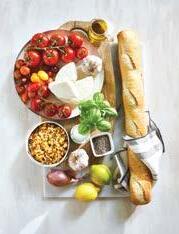
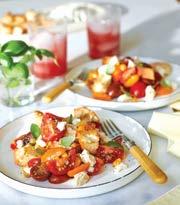
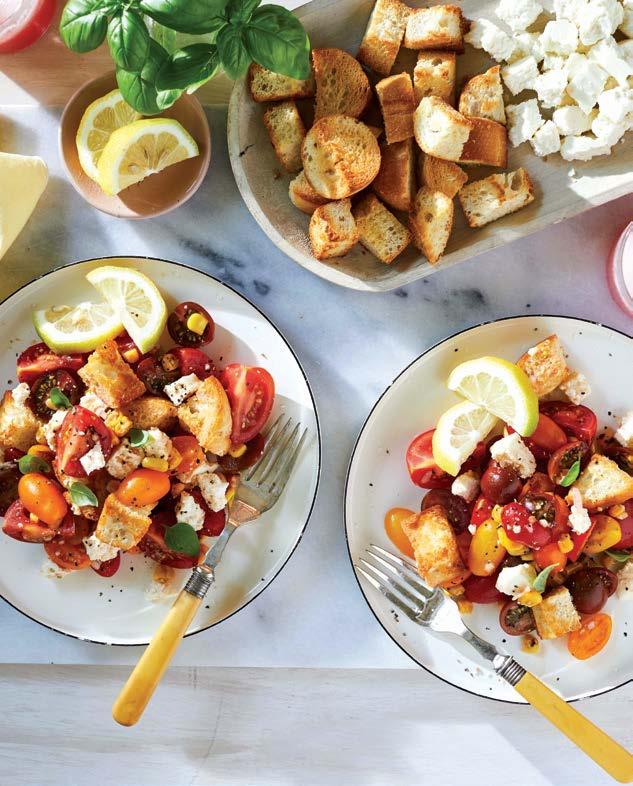
Recipe and photos by Pauline Stevens
3 c. roma tomatoes, cut in quarters
1 c. cherry tomatoes cut in half
½ c. roasted corn kernels
10 basil leaves chopped, plus a few whole for decoration
2 garlic cloves smashed
½ small shallot chopped
½ baguette cut in cubes
½ c. queso fresco or añejo cheese for a more salty taste
½ c. olive oil
1 large lemon
Salt
Pepper
Toast baguette cubes in the oven until slightly brown. Mix garlic, shallot, olive oil and lemon in a bowl. Add tomatoes and stir until well mixed. Add corn, cheese and bread, and mix lightly. Add basil, salt and pepper to taste.
Keep in refrigerator until ready to serve.
Recipe and photos by Pauline Stevens Serves 4
8 watermelon slices
1 medium cucumber peeled, half cut into cubes and half cut into slices for decoration
1/3 c mint leaves
PREPARATION
Cut watermelon slices into cubes and blend in a blender with ½ cup of water. Add the cubed cucumber and blend with watermelon mix. In a large pitcher, add mint leaves and slightly press. Strain watermelon and cucumber mix into pitcher. Serve with ice. Decorate with cucumber, watermelon and mint for an extra fresh look. Add lemonade for a delicious option.
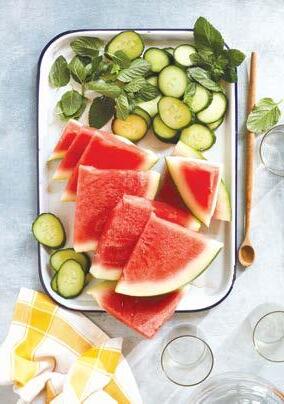
Beside her passion for photography, Pauline Stevens enjoys traveling and baking. She also visits every possible farmers market, even between frequent visits to NYC where her quadruplet sons live. Follow her store on IG @redbirdshouse.

In 2020, Tunisian-Texans Mansour and Karim Arem, both in their late 20s, launched their food company Zwïta with the production of harissa, Tunisia’s iconic condiment. This thick, spicy paste made from sun-dried peppers, olive oil, garlic, salt, caraway and coriander is a fundamental building block that adds depth and heat to the country’s cuisine.


The brothers descend from a line of strong Tunisian women who’ve guided their culinary views and practices. Although both were born in Houston, they lived part of their childhood in Tunisia and still regularly visit family there. “Our father wanted us to know our roots, where we come from,” says Mansour. The recipes for their products are ones they grew up with, and the company is named to honor their maternal great-grandmother.
Their beloved, hospitable grandmother, Béchira, has been an inspiration, cooking for them throughout their lives. In addition, the brothers credit their parents as huge influences, in equal but different ways. “Our mother taught us the importance of food, what it means to a culture and how to make it,” Mansour says. “Our father is an
endocrinologist and author who came to the states in the 1970s to practice and do medical research; he encouraged us to think scientifically but keep our romantic ideals. We talk to him all the time about the business and he helps us think things through.”
The idea of creating Zwïta germinated for some time. Both brothers graduated from Cornell University in New York. Mansour earned a master’s degree in Food Science and Technology with a specialization in Fermentation Science, and Karim received a master’s in Operations Research and Information Engineering. After graduating, both worked in New York City, where Mansour enjoyed cooking family recipes for friends, and they became acutely aware that quality Tunisian harissa wasn’t available in the United States.
“Industrially produced harissa is from peppers dried in ovens where they get ‘cooked’ and turn dark,” says Karim. “For true harissa, peppers must be dried slowly in the sun, so they retain their vibrant red color and fresh flavor.”
When COVID-19 shut down New York and Mansour was laid off from his Brooklyn Brewery job, the brothers decided to return to Houston and get serious about their dream of starting a Tunisian food business. While developing plans and processes, Karim continued his job at IBM and Mansour worked as a brewer at Houston's Karbach Brewing Company. In December of 2020, the Zwïta website went live and the perfected batches of three harissa variations
— mild, spicy and smoky — were ready for sale.
Although they’d done no serious advertising, interest in their harissas grew, mainly via social media. By summer 2021, both brothers were working fulltime on the business. Karim says, “We realized the potential of what we have and that we needed to focus on Zwïta 150 percent.” In 2022 they introduced a new line of products with a zucchini and potato shakshuka, ready to be combined with eggs. Tunisian-style shakshukas are tomato-based vegetable stews that feature poached eggs and include harissa, of course. Two more shakshukas — fava bean and spinach, and eggplant and sweet potato —
Their combined food science and data engineering skills have served them well. “We’ve learned so much in the past two years.” Mansour says. “I call it our lab phase because we’ve done so many iterations. We learn by doing and that’s how we’ve optimized our processes. By performing all the steps ourselves, we can see what’s too messy, too time-consuming, too tedious, and we figure out a better way.”
Now that they’re satisfied with the core group of six products (three harissas and three shakshukas), they are focusing their energies on marketing, ramping up production and expanding distribution throughout the U.S.
In addition to making all the products themselves — from rehydrating and grinding peppers to packaging the finished products and fulfilling the orders — the brothers maintain a lively website with recipes and blog posts about Tunisian cuisine. They publish an online newsletter and create Instagram videos featuring themselves and their family joyfully cooking and eating Tunisian dishes. Through these channels, they’ve created an enthusiastic community of fans.
“We’re not just producing food,” Mansour says. “We want to bridge a cultural gap; Tunisian culture is underrepresented and sometimes misrepresented in the U.S. Storytelling through food is fundamental for us; we want to educate people about how our cuisine is unique and delicious and shouldn’t just be grouped with generic
Middle Eastern or North African foods and flavors.”

While Tunisian cooking shares ingredients with other regional cuisines, one difference is that dishes feature more heat than those of its neighbors. Spicy peppers (Capsicum Annuum ), native to the New World, arrived in Tunisia in the 15th century when Muslims and Jews were expelled from Spain and settled on the Cap Bon peninsula. New varieties of peppers were developed there, including baklouti, which are the most common variety used for harissa. The Arem brothers have found that arbol and guajillo chiles from Latin America are extremely close in flavor to the peppers grown in Tunisia.
As a busy crossroads in the Mediterranean world, Tunisia’s history informs its rich culinary heritage. Originally inhabited by nomadic Berbers, it has been occupied by Phoenicians, Romans, Arab Muslims, Sicilian Normans and Ottoman Turks, all of whom contributed to Tunisian foodways. In 1881, France incorporated Tunisia into its colonial sphere as a protectorate; the country gained independence in 1956.
The smallest country in North Africa, Tunisia’s borders contain mountainous areas, deserts, extensive Mediterranean coastline and arable farmland. The region has been an agricultural center since Roman times when it was known as the granary of the empire. In addition to wheat and barley, the country produces beans, figs, grapes, dates, lemons, olives and olive oil. These ingredients along with lamb, fish, poultry and eggs — the most common proteins — combine to create a unique cuisine that features vegetable stews, grilled vegetable salads in olive oil, many variations of couscous and pasta.
Tunisia is second only to Italy in per capita pasta consumption and it produces unique shapes such as the small, flat squares called nwassar. Pasta dishes often incorporate Mediterranean seafood such as red mullet, octopus and cuttlefish in tomato- and harissa-based sauces. Coriander
and caraway are commonly used flavorings. A customizable spice blend called tabil comprises coriander, cumin, caraway, red pepper flakes, dried garlic, black pepper, bay leaves, ginger powder, dried mint and salt.
Tunisian sweets can be cookies and crisp pastries made with dates, figs and varieties of nuts. Assidat zgougou is a pudding made from Aleppo pine seeds, flour, sugar and milk, garnished with hazelnuts, almonds or pistachios. French influence is demonstrated in the popular street food casse-croûte tounsi, a baguette sandwich stuffed with preserved tuna, vegetables, hard-boiled eggs and harissa. It’s this varied culinary richness that the brothers want to share.
A big step in spreading the word about Tunisian cuisine and their products came in 2022 when Zwïta competed in H-E-B’s Quest for Texas Best food products contest. They won second place. The prize was $15,000 plus the opportunity for placement on H-E-B shelves. “It was an honor that we never expected,” says Karim.
In Tunisia, winning this prize was a big deal, and not only for the Arem family. Their grandparents’ entire village, El Jem, celebrated the brothers, who received lots of coverage by the Tunisian press, including interviews on national TV and radio.

In March 2023, Mansour and Karim unexpectedly lost their grandmother Béchira in El Jem. She was an influential touchstone throughout their lives; she is featured in many of their videos and she loved that Americans were interested in Tunisian foods. “All our recipes are Grandma -approved,” says Mansour. In honor of Béchira’s legacy, the brothers have dedicated themselves to making Zwïta the best it can be, telling their stories through food and bringing the family’s culinary traditions to a larger audience.
“We know that’s what she’d want us to do.” Visit at zwitafoods.com
It ’s a hot, slightly humid day in the Texas Hill Country as the sun beams down on my back porch. My daughters are playing in the yard, a neighbor down the street is mowing their lawn and I listen to the sounds of late spring — a mixture of giggles, buzzing lawn equipment, birds chirping, airplanes flying overhead and a gentle wind rustling the tree branches. I’ve found a little moment of mindful meditation while I take it all in and sip from a glass of Texas-grown, Texas-made Viognier (pronounced “vee-own-yay”). With its enchanting aroma of freshly-picked wildflowers; buttery mouthfeel; juicy notes of peach, tangerine and mango and crisp finish, it feels like the perfect drink choice for the transition to summer. It’s dry and refreshing but has enough fullness to keep things interesting. I stretch out my bare feet, feeling the grated texture of my weather-worn deck, and look down to notice the sunlight dancing through my wine glass, illuminating the nearly transparent, yellow-tinged color of the wine as if it were full of sunshine itself.
I’m not the only Texan captivated by Viognier. The dry white wine varietal, which has somewhat mysterious origins but is often thought to be an ancient grape dating back to Roman times, originally rose to popularity via the Château-Grillet AOC, a small appellation of the Northern Rhône valley of France.
Viognier’s long been sought out by connoisseurs, but, according to Texas winemakers, is only recently becoming one of Texas wine drinkers’ most-requested white wines.
Nichole Bendele, a Wine & Spirit Education Trust (WSET) Certified Level II Sommelier and the director of marketing, public relations and outreach for Becker Vineyards, located between Stonewall and Fredericksburg, shared that co-founder Dr. Richard Becker was the first to grow Viognier in Texas. “He nicknamed it the ‘red wine drinker’s white wine’ because of its fullness on the palate like a red wine. His first experience with Viognier was Château-Grillet’s Viognier from the Northern Rhône region of France,” she says. “He fell in love with the wine! It’s his favorite white wine.” Bendele says that Becker Vineyards planted Viognier in 1993, just one year after the winery was established, and first harvested Viognier in 1996. In her 26 years working at Becker Vineyards, she’s seen their production grow from 2,500 cases to almost 100,000 cases annually.
Although the varietal was not familiar to customers in Texas at the time, and despite its tricky-to-pronounce name, Dr. Becker and his late wife and vineyard co-founder Bunny bet that their customers would grow to love Viognier as much as they did. “The Beckers and staff encouraged guests to try Viognier. If someone is a red wine
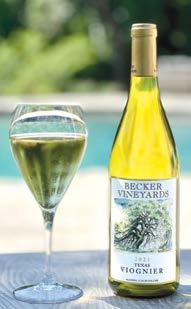
drinker, it is a white wine they are open to. It is a dry-style wine but because of the fruit notes, some people who enjoy off dry wines enjoy it, too,” she says. “The Viognier is our number one selling white wine and a flagship wine for us.”
For fellow Texas wine lovers and those of you who have been visiting Texas Wine Country through the years as I have, you may have observed Viognier popping up as a staple on tasting menus and wine lists as our state’s wine scene continues to grow and evolve.

There seems to be an ever-increasing number of wineries and vineyards in Texas, with more than 50 in the Texas Hill Country alone — from Austin to Fredericksburg and Lampasas to New Braunfels — according to the nonprofit trade association Texas Hill Country Wineries. A significant portion of these Texas wineries are choosing to grow, make or serve Viognier.
“About 10-15 years ago, there were just a few wineries making Viognier here in the Hill Country or even growing it across the state,” says January Wiese, executive director of Texas Hill Country Wineries.
“Now, Viognier is in the top five varieties grown in Texas and we estimate 80 percent of Texas Hill Country Wineries members produce one.” Since wine drinkers may be more familiar with mass-distributed white wine varietals like chardonnay and pinot grigio, wineries have banded together to help spread the word about Viognier and share information with their customers. “With the success of Viognier in Texas, it's been a focus for the industry to share and educate consumers about the varietal and we've noticed it's taken the place of more popular white wines for many guests,” says Wiese.
Beyond its delicious taste and luxurious mouthfeel, what’s helped Viognier stand out across the plethora of wine options available to us in Texas? Especially when it was described to me by several local winemakers as “finicky” and “unpredictable” to grow?
Kyle Johnston, co-owner and head of wine production at Haak Wines in Sante Fe, Texas, located between Houston and Galveston, is excited to be pouring a newly released 2022 vintage of Viognier this summer. “When you have something great, you almost don’t want to talk about it because you don’t want to jinx it,” he says. He shares that Haak’s 2022 Viognier is his favorite in Texas — the grapes for the wine came from Reddy Vineyards in the High Plains and were harvested early to help retain freshness and acidity. “On a good year,” Johnston says, “Texas Viognier can match any Viognier in the country.” He warns, however, that it’s not consistent or reliable. “It still feels like a longshot when you plant vines here in Texas. We’re in the infancy of Texas viticulture.” For this reason, he says Haak Wines tends to plant hybrid grape varieties that are more disease resistant and drought tolerant. But it's been a great year for Viognier, and I can read in his voice that the risk of working with this lowyield, tricky varietal must have paid off. Johnston describes Haak’s 2022 Texas High Plains Viognier as “having a thickness that lasts, and aromatics that are just beautiful.”
“[Viognier is] not at the top of my list for being resilient to our weather extremes,” says Dave Reilly, winemaker at Duchman Family Winery in Driftwood. Like Haak Wines, Duchman chooses to source its Viognier grapes from the Texas High Plains because he appreciates the quality. Duchman sources its Viognier from Bingham Family Vineyards and then makes the wine in Driftwood. Why go through the effort to producea wine like Viognier when there are varietals that do well at their estate vineyard? Reilly explains, “I think wines should pair with climate and food. Texas is hot and Texas has seafood, our Viognier pairs nicely with both of those.”
Duchman’s first vintage of Viognier is from 2007, and Reilly shares that their customers have come to request their Viognier over time. “As with any varietal that isn’t as well known as chardonnay or cab, it takes time to introduce it to people. After they are introduced, they fall in love with it.”
Reilly touched on another element that makes Viognier popular across the state — it pairs well with food, from seafood to red meat to spicy dishes. It’s a sentiment that sommelier Bendele shares, “It is a food friendly wine. Pork is not an easy meat to pair wines with but Viognier goes beautifully with a peppered pork loin! You can serve it with spicy fare … it is a popular pairing with Asian cuisine. It does have a light acidity that works well with cream-based dishes.”
This dynamic quality that allows Viognier to be paired with so many different foods is also something that makes it appealing to Texas winemakers who like to innovate. With a versatility that lends itself to both fermentation in stainless steel or aging in oak barrels, Texas winemakers are putting their own stamp on Viognier to express the flavors and acidity levels they prefer. You can taste your way through several Texas wineries and find Viognier wines that are vastly distinct from one another, which makes the varietal all the more exciting.
For example, Reilly describes Duchman’s Viognier, which is 100 percent stainless steel fermented and never oak aged, as having “aromas of white flowers, lemon and lime,” and “mandarin oranges and citrus on the palate.” Bendele describes Becker’s Viognier Reserve, which is aged 10 months, 95 percent in French oak barrels (70 percent of which are new), and 5 percent in a stainless steel tank. “When you give a gentle swirl to the Viognier, you notice the nectar-like nose with a zest of lime and hint of Gardenia flower. Taking a sip of it, you continue tasting citrus notes on the palate along with pear and light vanilla.” While they describe the nose in a similar way, they describe the palate differently. The variety makes a fun experience for wine lovers who enjoy comparing notes and exploring subtleties and also for anyone just looking for a bottle to keep on hand to fit any meal or occasion.

From the perspective of this native Texan and wine drinker, Viognier is bold and versatile like Texas. It’s a wine that’s complex yet approachable, as unpredictable as our weather, fragrant like our wildflowers in the spring and vibrant like a bright summer day by the river. It’s easy to drink in the heat and to pair with the foods we love. It’s dynamic enough for Texas entrepreneurs to make it their own. All of this and more is what makes it a great Texas wine.
I invite you to drink local and support Texas businesses this summer! Whether you’re new to wine or an absolute maven, Texas wineries have something for you. Grab a glass of Texas Viognier and you’ll see why so many Texas winemakers and wine drinkers have fallen in love with this varietal.

Becker Vineyards
464 Becker Farms Rd.
Fredericksburg 78624
beckervineyards.com
@beckervineyards
Bell Springs Winery
3700 Bell Springs Rd.
Dripping Springs 78620
bellspringswinery.com
@bellspringswine
Duchman Family Winery
13308 FM 150 West Driftwood 78619
duchmanwinery.com
@DuchmanWinery
Grape Creek Vineyards
10587 US Hwy. 290
Fredericksburg 78624
grapecreek.com
@grapecreekvineyards
Haak Wines
6310 Avenue T Santa Fe, TX 77510
haakwines.com
@haakwinery
Messina Hof Winery
Bryan Estate Winery 4545 Old Reliance Rd.
Bryan 77808
Harvest Green 8921 Harlem Rd. Richmond 77406
Hill Country 9996 US Hwy. 290
Fredericksburg 78624
messinahof.com
@messina_hof
Pedernales Cellars 2916 Upper Albert Road
Stonewall, TX 78671
pedernalescellars.com
@pedernalescellars
Perissos Vineyard and Winery 7214 Park Rd. 4 W. Burnet 78611
perissosvineyards.com
@officialperissosvineyards
Ron Yates
6676 Hwy. 290 W. Hye 78635
ronyateswines.com
@ronyateswines
Solaro Estate Vineyards & Winery
13111 Silver Creek Rd. Dripping Springs 78620
solaroestate.com
@solaroestatewinery
Texas Heritage Vineyard 3245 US Hwy. 290 E. Fredericksburg 78624
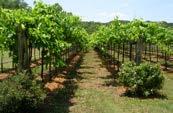
texasheritagevineyard.com
@texasheritagevineyard



In between bustling city streets and modern buildings, there is a reallife castle nestled in the heart of downtown San Antonio. W ith its stunning limestone arches, intricate architectural details and beautiful grounds, it is no surprise that the Lambermont has become the go-to place for portrait sessions, weddings, showers and other events in the San Antonio area.
Originally built in 1894, the castle was purchased in 2008 by the current owners, Dona and Pat Liston. “We spent three years restoring it back to its original footprint and updating everything,” explains Dona. Now, Lambermont is more than just a building – it’s a destination, a place where people can come together to celebrate life's special moments.
From the ornate chandeliers to the intricate woodwork, Lambermont is a true masterpiece. “We want people to feel at home,” says Dona when asked about what makes the atmosphere of Lambermont so special. For those seeking a wedding venue, Lambermont is the perfect place to say "I do." “The property is a blank canvas that we use to create the vision for our couples,” Dona explains. Able to fit up to 300 people on the grounds and with private overnight bedrooms for guests, Lambermont is the perfect place to host an unforgettable event,
whether it’s an intimate wedding or a full destination weekend.
As a family owned business, Dona and her daughter Erica are passionate about creating unforgettable experiences for
Whether you're celebrating a wedding, hosting a shower, or planning a corporate event, Lambermont promises an unforgettable experience that will leave a lasting impression on you and your guests.
LAMBERMONT AMENITIES
• Historic, breathtaking venue
• Full range of customizable packages
• Spacious, timeless interiors
• Immaculate & intimate lodging
• Brunch & lunch packages
• Elevates any occasion
• Family-run
their guests, and go above and beyond to ensure that every detail is perfect. “I was a wedding planner for over 20 years before I bought this home so we’ve been in the industry for over 30 years” says Dona.
Lambermont’s owners have continued to upgrade and restore the property, recently adding a new art edition to the grounds. A massive live oak tree once sat in front of the venue for over a century. Sadly it was confirmed this tree was dying and would need to be cut down but, instead of getting rid of the tree, Dona says, “I wanted to continue creating art with what could have been thrown away.” They hired an Australian artist, based in Texas, who carved the tree.
Lambermont is a true masterpiece.
“The building has amazing history and our couples are the newest part of its history with their celebrations” says Dona.
Lambermont is located at 950 East Grayson Street, San Antonio, TX 78208.
For more information or to schedule a tour, visit lambermontevents.com.
Back in the 70s, travels to southern France inspired some of the early Texas Hill Country winemakers who imagined that if grape vines thrive in the French climate, they would here, too. Some of the first Texan lavender growers had that same epiphany. Dr. Richard Becker and his late wife Bunny, co-founders of Becker Vineyards, fell in love with lavender while traveling through Provence. Recognizing the climate was similar to that of Fredericksburg, they decided to plant lavender in addition to growing grapes and making wine.

In 1999, Robb Kendrick and Jeannie Ralston opened one of Texas’ first lavender farms in Blanco. Same story: On a trip to Provence for Kendrick’s work as a National Geographic photographer, he was struck by the similarities between the landscape and his home. He figured lavender would grow just as well in Blanco’s rocky terrain and smoldering summers. They came home and started Hill Country Lavender. While lavender farming hasn’t exploded on the Texas scene with the same boom that winemaking has (nothing can compete, nor does it need to, with wine), it has become a thriving industry in Central Texas. Those early growers were right about the climate being perfect for lavender. It’s also healthy for our ecosystem as it’s a great source of pollen and nectar for bees and other pollinators. And the plant’s beauty, hardiness and soothing fragrance have made it popular with residents and tourists alike.
“It’s not just your grandmother’s scent anymore,” says Tasha Brieger Corradini, current owner of Hill Country Lavender. As people have become more educated about holistic living and essential oils, lavender’s appeal is blossoming. Not only is it calming — helping with stress, anxiety and sleep — it may also alleviate headaches; soothe sunburns, cuts and scrapes; and repel bugs (place some in your closets and drawers to keep out moths and scorpions). Mixed with other oils, it can be enjoyed without making you too sleepy. Lavender also has many culinary uses; it’s especially delicious in cocktails!
While lavender isn’t a needy plant, and does rather well in droughtprone Texas, the one thing it does require is the right soil: alkaline and

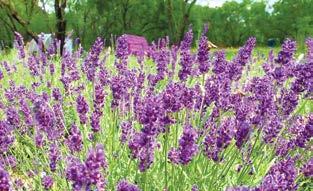




well-drained. The plants are normally dormant between October and April, but the exact timing of the blooms can be affected by abnormal weather (like “Snowmegeddons” or ice storms). There are 490 varieties that come from France, Spain and England, so for those who may want to try their hand at growing lavender at home, there are many options to choose from.
“I always tell people to plant eight or ten different varieties and give it two to three years to see what happens and which ones are happy,” says Corradini. Baby plants do need a good drink of water every few days for the first six months of their life. After they’re established, they need very little. “They’re actually a stress-driven plant. If you’re too nice to them, they won’t bloom!”
Once lavender is cut, typically over a six-week period in May and June, it’s hung to dry and the oil is extracted to use in various products, or the buds are stripped and then used in food and drink recipes. Whether you’re interested in learning about growing or cooking with your own lavender, finding some delightful home and health products or taking a day trip to a beautiful farm in the country, check out what these Texas farms have to offer!
Becker Vineyards is arguably one of the most beautiful in Fredericksburg with its fields of vines, flowers and lavender nestled on 308 acres, a mile or so off the well-worn path of U.S. Highway 290. Increasing the artistry of the fields, the Becker family added red poppies, bluebonnets and zinnias. The lavender plants have occasionally succumbed to drought, flash flooding and snow storms, but the family has always replanted, and they’re now sticking with the Stoechas (Spanish) varietal that seems to tolerate these weather events the best.
Visitors to Becker Vineyards enjoy sipping on delicious wines while gazing upon, or strolling through, Clementine’s Garden, the fields of flowers named in honor of the late Clementine “Bunny” Becker. They offer a variety of lavender products, sold both at the estate tasting room and their Main Street tasting room location. The products include handmade lavender soap, eye pillows, sachets, lotion, shower gel, grape seed scrub, lip balm, candles and much more.
The Beckers started Lavender Fest in 1998 as well. The festival features vendors, mostly with the theme of gardening and cooking, a “Meet Your Maker” bar for wine tastings and live music, all in the serene setting of the stone pavilion right next to the gardens. They also have a Lavender Bites and Wine Pairing so guests can learn more about cooking with lavender, as well as a Lavender Luncheon.
In addition to the annual festival, Becker Vineyards has a flourishing all-inclusive events program, including an Estate Chef and partnership with Hill Country Catering, allowing customers to host whatever type of private event — from corporate dinners to birthdays and rehearsal dinners — in as easy a manner as possible.
beckervineyards.com
Jim and Debbie McDowell moved from Houston to their 23-acre farm in Brenham in 2001 with no intention of growing lavender. When they decided they wanted to make use of their land, they did a lot of research into what would thrive, and planted 20 lavender plants. They now grow thousands of Sweet and Provence hybrids that do well in heat and humidity. The oil from the plants is used in all of their products, which are handmade — mostly by Debbie. They offer a line of products called Nature’s Remedies that includes teas and spices, soaps, candles and other handmade crafts in their gift shop.
Unlike fields in the middle of the Hill Country, the lavender fields at Chappell Hill require a lot more maintenance because they don’t like the wetter conditions. Because of that challenge, they’re one of only a few lavender farms in the area that remain open to the public regularly. Visitors to the farm can enjoy strolling around the fields; picnicking at the gazebo by a pond; feeding Fonzie, Oreo and Moon Shine — the resident miniature goats; stocking up at the gift shop; and picking blackberries, peaches, pears, persimmons and more when the fruit is ripe. They also offer a variety of plants for sale and free tours.
The lavender cutting season is typically May–June and August–October, during which visitors can cut their own bundles of lavender for $5. On the outdoor deck, Chappell Hill provides seminars, yoga, painting classes, educational classes and private parties when the weather is nice. Annually, they host "Celebrating Mom's Spring Fling Event" on the day before Mother's Day, and they participate with The Art Walk (in conjunction with the Chappell Hill Chamber of Commerce) each May and The Airing of the Quilts each September. chappellhilllavender.com

Ann and Rob Karns moved to their farm about 40 miles southwest of San Antonio in 2009, and they set out to transform the land from cactus and mesquite to a working farm. They started out with a vegetable garden, chickens and goats and native grasses. Ann came across a story in a gardening magazine about a lavender farm in Virginia, and she thought, “I have a lavender plant growing in my vegetable garden and it’s surviving without any care. Maybe we could grow lavender.” That’s when, in 2016, the couple went to work clearing mesquite and preparing the land for 1,500 lavender plants.
The Doe-Re-Mi Lavender Farm is always evolving, and the couple loves every minute of farm life. Visitors are able to experience a lovely, peaceful day in the country — picnicking; tasting herbs in the greenhouse and gardens; feeding the goats, alpacas and Donkers, the guard donkey; and shopping for lavender products, propagated lavender plants and garden and gift items. Customers can also cut their own lavender bundles or take a tour and experience the distillation of essential lavender oil. You can leave the farm with not only lavender products, but also eggs from their chickens and yarn made from alpaca wool.
Ann is a talented cook, and the farm also offers cooking classes in which she shares her lavender baking secrets. A unique addition, the new Farm Café serves up her homemade treats — including scones, shortbread, cakes and coffees — as well as their son William’s gelato made with the farm’s eggs, mint and lemon balm. The farm is a great place for private
2 oz Gin (Dripping Springs)
1 oz Fresh Grapefruit
½ oz Fresh Lime
½ Lavender Simple Syrup
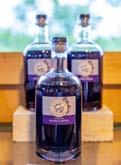
2 oz Club Soda (optional) Ice
GARNISH
Lavender Sprig

Grapefruit wedge
PREPARATION
1. Add all ingredients except Club Soda to a cocktail mixing glass
2. Stir and strain into glass.
3. Top w/ soda & add fresh ice cubes.
4. Garnish w/ a Grapefruit wedge and a lavender sprig.
parties, school groups, garden club gatherings and more. The Karns family has made it a truly special place that they love to share with others. doeremilavender.com
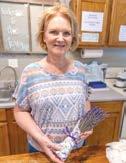

Tasha Brieger Corradini, Blanco Chamber of Commerce president, had been working at Hill Country Lavender since she was 16. Founder Robb Kendrick convinced her to buy the farm when she was still in college, in 2005. She thought it’d be a fun, temporary thing until interest in lavender waned, which it never did. Instead, Blanco became the Lavender Capital of Texas and is host to the annual Blanco Lavender Festival each June. For a fun-filled weekend, the downtown square comes alive with music, shopping, beer, wine and food, and special events take place out at the farm. Visitors are welcome at the farm any time they’re open to cut lavender when it’s blooming or to just enjoy a picnic among the plants.

While breathing in the plant’s aroma or cooking with lavender are the best DIY uses, Hill Country Lavender distills the buds to create the essential oil that is the key ingredient for their bevy of products — from soaps and aromatherapy sticks to bug sprays and dog shampoos — all handmade by Corradini’s husband RG and available at the farm’s shop and on their website. Also on their website, you’ll find enticing cocktail photos and recipes, all created by Corradini too. hillcountrylavender.com

LAVENDER SIMPLE SYRUP
1c. sugar
1c. water
2T. culinary lavender
PREPARATION
1. In a small saucepan combine water, sugar and bring to a light simmer.
2. Stir until sugar is dissolved
3. Remove from heat and stir in lavender.
4. Allow to cool to room temp.
5. Strain to remove lavender and set syrup aside to cool.
6. Keep refrigerated until needed.
Writer and editor Ashley Brown lives in Wimberley with her family of rescues: a dog, two cats, and two donkeys. In addition to animal welfare, her passion is exploring the Hill Country's natural beauty, small farms, eateries and drinkeries.
“It’s not just your grandmother's scent anymore."Left Page: Tasha and RG Corradini and bubble bath from Hill Country Lavender Right Page: Debbie McDowell and the store at Chappell Hill Lavender Farm

















